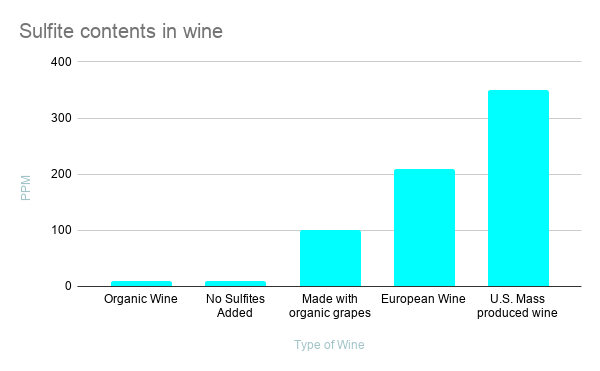Sulfites in Wine
In this article, we will discuss why sulfites are in wine, why wines have different levels of sulfites, and what this means for people with sulfite sensitivity.
What are sulfites, and why are they in wine?
Sulfites are a preservative used in wine to prevent bacteria and yeast growth and to prevent spoilage of wine from oxidation. While sulfites are often added to wine, wine naturally contains some sulfites because sulfur dioxide is released upon fermentation.
If you are reading this article and have discovered sulfites are a culprit of your discomfort or have a different food intolerance, I’m hoping you can learn from my story and really improve your overall health as I have been able to with this knowledge. Being the one who always gets ‘sick’ or the one who has the ‘sensitive stomach’ causing date nights to be cut short is not fun. Not being able to play with your kids in the morning because you’ve spent the night in the bathroom instead of your cozy bed is disheartening.
Wine and headaches. Is it due to the sulfites?
The short answer is, most likely not. Unless you are part of the 1 in 100 people sensitive to sulfites, tannins, histamines or dehydration are more likely causing headaches related to wine consumption.
Drinking water sips while drinking wine may help lessen these headaches.
This being said, if you do have a sulfite sensitivity, drinking wine can cause headaches, nausea, vomiting, fatigue, brain fog, asthma flare-ups, chest tightness, throat swelling, and any other symptoms that are triggered by sulfites in other foods.
Wine gives me headaches and more
Prior to my discovery of my sulfite intolerance, I got sick off of wine and cocktails so many times, the last time being in Napa that I just don’t enjoy wine very much anymore.
One scenario replayed itself many, many times. I would get sick after having a nice dinner at a steakhouse or other ‘fancy’ dinners (fancy translate into ‘with wine or cocktails’). Sometimes we would barely make it home in time. I would spend the rest of the night vomiting, dizzy, sitting or hanging over the toilet and would eventually fall asleep on a towel in the bathroom. Understandably, my husband was always so confused about how and why I was so sick. Did I sneak drinks? Or maybe I drank on an empty stomach? Did I get food poisoning? Am I allergic to something? The next day I would be tired and have a sour stomach and virtually be glued to the couch for the rest of the weekend.
I knew I wasn’t allergic to anyone food but couldn’t figure out another common factor. I don’t know why I didn’t even realize it was the wine or other cocktails. Maybe because I would get sick from eating out even if I didn’t drink any alcohol. I’m proud to say, unless sulfites sneak past me in food, when we go out to eat, I don’t get sick and am able to enjoy not only the evening but also the rest of the weekend.
How many sulfites are there in wine?
The standard measurement for sulfites is ppm. In the U.S., if a food or beverage has more than 10ppm of sulfites, it must be labeled that it contains sulfites. Typically, U.S. wines will have 200 ppm and should not contain more than 350 ppm. Organic wine is limited to 10 ppm, while wines ‘made with organic grapes’ try to keep limits at 100 ppm. As far as European wine, the usual limit is 210 ppm. Compare this to other common foods with sulfites such as dried fruit, bottled lemon and lime juice which contain about 200 ppm while dried instant potatoes can contain up to 400 ppm.
Sulfite free wine
Sulfite free wine can not exist due to the natural existence of at least some sulfites in wine as discussed above. For those of us that can tolerate some but not a lot of sulfites, a good ‘no sulfite added wine’ can be an exciting find. Though I rarely drink wine, when I do, I enjoy Frey Wines, one of the oldest organic and no sulfite added wineries in the U.S. I have found their product to be consistent, clean and easy to drink.
Sulfite Wine Filters
Sulfite Wine Filters, tools that oxygenate wine, claim to reduce sulfites by 10 to 30 percent. A few commercial products are available for purchase. Whether or not these products help eliminate wine-related headaches is debatable. Efficacy may vary from person to person. I have tried a sulfite purifier once. I’m not sure if I’m just scared, but I still had a slight headache and nausea. I did not vomit and I felt okay the next day, so they may help reduce levels of sulfites. Occasionally, if I’m really craving a glass of red wine, I’ll have one glass of Frey or some other ‘USDA Organic Wine’.
Have you tried a Sulfite Wine purifier? If so, please share your thoughts with me by leaving a comment or you can email me at [email protected].




